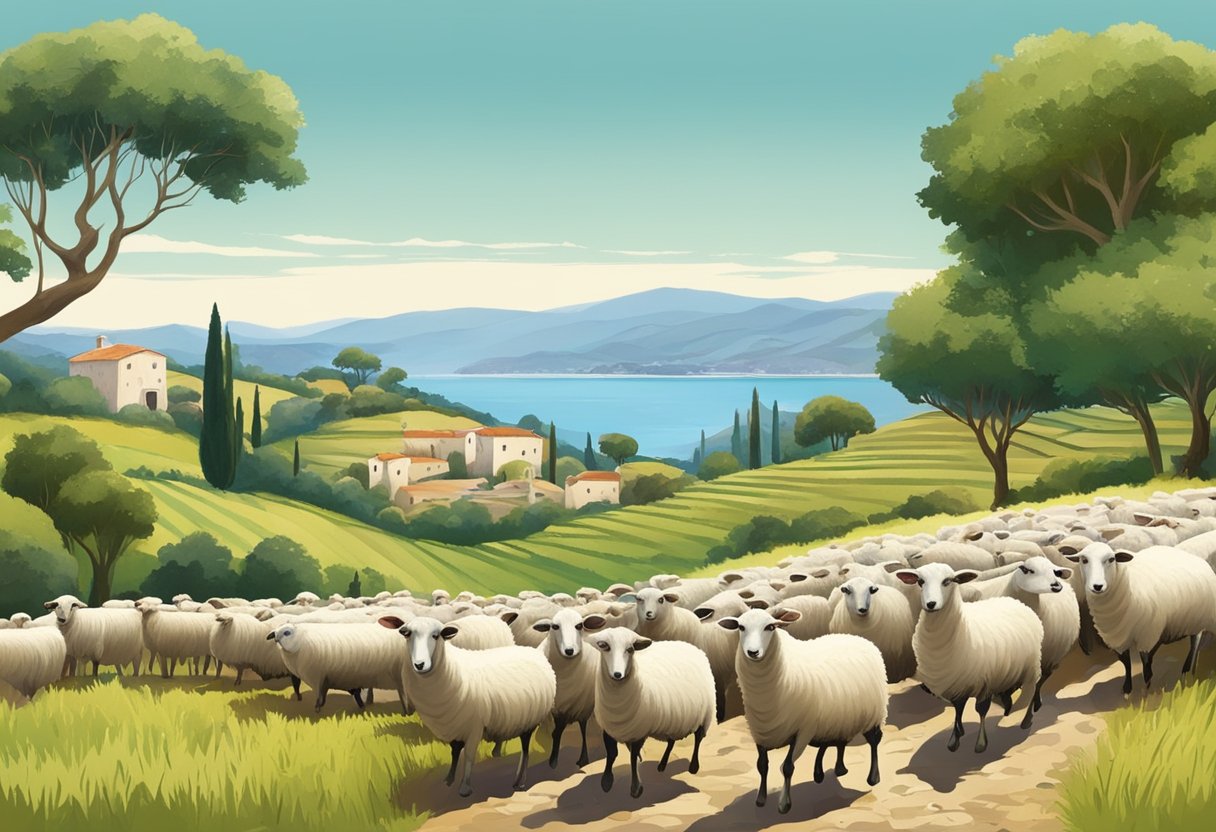Adopting a gluten-free diet is essential for individuals with celiac disease or non-celiac gluten sensitivity. This dietary need excludes gluten, a protein found in wheat, barley, and rye, which can trigger harmful reactions in affected people. The Mediterranean diet, renowned for its health benefits, emphasizes the consumption of whole grains, which traditionally contain gluten.
However, the principles of the Mediterranean diet can be adapted to fit a gluten-free lifestyle by choosing gluten-free whole grains and incorporating practices such as herding and the use of dairy products with care.

Herding plays a significant role in providing fresh, nutrient-rich dairy which can be included in a gluten-free Mediterranean diet. Dairy products like cheese and yogurt contribute to the diet’s appeal and nutritional value, but those who have sensitivities to both gluten and lactose must choose lactose-free or dairy alternatives.
Meanwhile, gluten-free whole grains, such as quinoa and rice, allow for the inclusion of essential fibers and vitamins, aligning with the traditional benefits of the Mediterranean diet without compromising health for those with gluten-related disorders.
Key Takeaways
- Individuals with gluten sensitivities can enjoy the health benefits of a Mediterranean diet by selecting gluten-free grains.
- Dairy, sourced through herding, can be integrated with lactose intolerance considerations.
- A gluten-free Mediterranean diet maintains nutritional value while avoiding gluten-triggered health issues.
Table of Contents
Understanding Gluten and Its Effects
Gluten is a group of proteins found in certain grains such as wheat, barley, and rye. It has a significant impact on individuals with celiac disease, non-celiac gluten sensitivity, and wheat allergy. This section explores the intricacies of gluten, its role in the diet, and how the Mediterranean gluten-free diet can be beneficial.
Gluten Components and Sensitivities
Gluten is composed mainly of two types of proteins: gliadin and glutenin. These proteins can trigger an adverse immune system response in people with celiac disease—a chronic autoimmune disorder where ingestion of gluten leads to damage in the small intestine. Non-celiac gluten sensitivity and wheat allergy are other conditions that necessitate a gluten-free diet.
Gluten Presence in the Mediterranean Diet
The traditional Mediterranean diet includes foods like bread, pasta, couscous, and beer that contain gluten. However, adhering to a Mediterranean diet doesn’t mean these items are off-limits—as gluten-free alternatives are increasingly available, allowing people with sensitivities to enjoy Mediterranean cuisine without the gluten.
Health Implications of Gluten
For those with celiac disease, consuming gluten can result in symptoms such as diarrhea and bloating, and may lead to chronic diseases due to malabsorption. Non-celiac gluten sensitivity can produce similar symptoms, while a wheat allergy can trigger a range of immune responses.
Nutritional Considerations in Gluten-free Diets
A gluten-free diet must still provide essential nutrients, vitamins, and minerals. Individuals must ensure adequate intake of iron, calcium, vitamin D, and vitamin B12. A Mediterranean diet with a focus on naturally gluten-free foods can provide a nutritionally balanced diet.
Gluten-free Diet and Weight Management
Maintaining a healthy body mass index on a gluten-free diet involves mindful eating, as many gluten-free products may be high in calories. Incorporating meat products, fruits, vegetables, and unprocessed snacks within a gluten-free Mediterranean diet can support weight management efforts.
Regulatory and Quality Aspects of Gluten-free Products
There are regulatory standards that dictate what can be labeled as a “gluten-free” product. The quality of gluten-free alternatives is essential for the safety of consumers, especially considering the health risks associated with inadvertent gluten consumption by those with gluten-related disorders.
Living with Gluten-related Disorders
Individuals living with celiac disease or non-celiac gluten sensitivity need to monitor their dietary intake closely. Consultation with a registered dietitian can ensure nutritional adequacy and adherence to a gluten-free diet, providing health benefits and symptom relief.
The Mediterranean Diet Dynamics

Understanding the Mediterranean diet involves recognizing its fundamental ingredients and health impacts. This diet emphasizes a diverse mix of foods and nutrients conducive to good health, with a particular focus on the role of quality fats, whole grains, and fresh produce.
Key Components of the Mediterranean Diet
The typical Mediterranean diet includes a high intake of:
- Vegetables and fruits: Serve as primary sources of vitamins and antioxidants.
- Whole grains: Provide essential fiber and nutrients.
- Nuts, legumes, and seeds: Offer proteins, healthy fats, and fiber.
- Olive oil: The primary source of dietary fat, high in monounsaturated fats.
- Dairy products: Consumed in moderation, such as cheese and yogurt.
- Proteins: Mainly from fish and poultry, with limited meat and eggs.
- Wine: Often consumed in low to moderate amounts, with meals.
For those with gluten intolerance, gluten-containing grains are substituted with gluten-free options like quinoa, buckwheat, millet, and rice.
Nutritional Profile and Health Benefits
This diet is associated with a balanced nutritional profile that includes:
- A balance of carbohydrates, proteins, and lipids.
- High levels of dietary fiber.
- An abundance of vitamins and minerals.
It has shown benefits in reducing risks for cardiovascular disease, coronary heart disease, and type 2 diabetes.
Adherence and Lifestyle Considerations
Adherence to the Mediterranean diet is not only about food choices but also embraces a lifestyle that includes regular physical activity and shared meals. Key aspects include:
- Emphasizing dietary intake of plant-based foods.
- Regular movement or exercise.
- Strong adherence to the diet’s principles.
Cultural and Environmental Influences
The Mediterranean diet reflects the eating patterns of regions like Italy and other coastal Mediterranean areas, with a strong link to local farming and sustainable practices:
- Use of local and seasonal produce.
- Preference for extra virgin olive oil.
- Emphasis on locally sourced fish and seafood alongside moderate wine consumption.
Modifying the Mediterranean Diet for Gluten Intolerance
For individuals with gluten-related disorders like celiac disease, the Mediterranean diet can be tailored to be gluten-free by:
- Excluding traditional gluten-containing whole grains.
- Including naturally gluten-free grains such as oats (certified gluten-free), quinoa, buckwheat, millet, and rice.
In this way, the diet maintains its nutritional integrity while accommodating gluten intolerance.
Integrating Dairy in Gluten-free Mediterranean Diets

In managing a gluten-free Mediterranean diet, understanding how to incorporate dairy properly is crucial. This not only maintains the diet’s nutritional balance but also supports the dietary requirements of individuals with conditions like celiac disease.
The Role of Dairy Products
Dairy products like milk, yogurt, and cheese are integral to a Mediterranean diet, providing essential nutrients such as calcium and vitamin D. Milk serves as a primary beverage, whereas yogurt and cheese are common for adding texture and flavor to meals. It’s important to ensure that these dairy products are truly gluten-free, meaning they contain no gluten-containing additives or have been cross-contaminated during processing.
Dairy Alternatives and Lactose Intolerance
Lactose intolerance can complicate the inclusion of dairy in a diet. Fortunately, there are dairy alternatives available that are both gluten-free and lactose-free, enabling individuals to enjoy the benefits of a Mediterranean diet without discomfort. These options include plant-based milk like almond or soy milk, and lactose-free versions of traditional dairy products, securing the diet’s nutrient profile.
Gluten Contamination in Dairy Products
Dairy products can become cross-contaminated with gluten through shared facilities or equipment. Gluten-free labeling on dairy products must be critically assessed — especially for those with celiac disease. Foods like whey protein concentrate can be a concern if derived from facilities processing gluten. It’s recommended to choose dairy items with a clear gluten-free certification to minimize risks of gluten exposure.
Incorporating Herding in the Gluten-free Diet

In a gluten-free Mediterranean diet, incorporating herding practices such as grass-fed and free-range methods can enhance the nutritional value of meat and dairy products while promoting environmental sustainability.
Benefits of Grass-fed and Free-range Practices
Grass-fed and free-range herding practices bring several health and environmental benefits. Meat and dairy from animals raised in these conditions tend to have higher levels of omega-3 fatty acids and antioxidants. For those following a gluten-free Mediterranean diet, these products represent nutrient-dense options that align with the diet’s emphasis on healthful fats. Moreover, grass-fed herding can have a lower environmental impact compared to traditional farming, as it allows animals to graze naturally, reducing the need for feed production and potentially lowering greenhouse gas emissions.
Alternative Sources of Protein
In addition to grass-fed meats, individuals on a gluten-free Mediterranean diet have a variety of protein sources to choose from. These include legumes like lentils, beans, and peas, as well as nuts and seeds. Incorporating legumes provides the dual benefit of protein and fiber, both essential for a balanced diet. In terms of herding, fish and seafood, obtained through sustainable practices, offer high-quality proteins while aligning with the Mediterranean dietary patterns.
Challenges and Considerations for Farmers
Farmers transitioning to grass-fed and free-range herding face several challenges. Initial cost is a consideration, as changing to these methods can require significant investment in land and resources. Moreover, maintaining a local and sustainable operation that fulfills the demands of a gluten-free Mediterranean diet might necessitate additional marketing efforts to reach the right consumer base. Despite these challenges, the shift towards such practices can meet consumer demand for health-focused and environmentally conscious food choices.
Rethinking Grains and Cereals
In the context of a gluten-free Mediterranean diet, the selection and preparation of grains are critical. Details on alternatives, the significance of whole and ancient grains, avoiding cross-contamination, and the link between grain cultivation and sustainability frame this section.
Gluten-free Grain Alternatives
For those adhering to a gluten-free Mediterranean diet, grains such as quinoa, buckwheat, and millet offer nutritional benefits without the gluten found in traditional cereals. They serve as excellent substitutes for wheat or barley and can be used in a variety of dishes, from salads to risottos. These grains provide important nutrients and are versatile components of a diversified diet.
- Quinoa: A complete protein containing all essential amino acids.
- Buckwheat: Rich in antioxidants and fiber.
- Millet: Alkaline grain, easy to digest.
Importance of Whole and Ancient Grains
Whole grains, which include the entire grain kernel, and ancient grains, which are often less modified from their original form, are fundamental parts of this diet. They offer an abundance of nutrients, including significant amounts of fiber, which supports digestive health. Grains like oatmeal and rice can be integral parts of a gluten-free diet when confirmed to be free from gluten contamination.
- Whole Grains: Provide more fiber and nutrients than refined grains.
- Ancient Grains: Often grown with fewer pesticides and herbicides.
Avoiding Cross-Contamination with Gluten
Cross-contamination with gluten-containing grains can be a serious issue for those with celiac disease or gluten sensitivity. It is vital to ensure that gluten-free products are handled and processed separately from gluten-containing ones. Measures such as using dedicated equipment and facilities can help prevent contamination and guarantee the safety of gluten-free grains.
- Strategies to avoid cross-contamination:
- Use separate kitchen tools and appliances for gluten-free products.
- Purchase certified gluten-free grains and grain products.
Grain Cultivation and Sustainable Agriculture
Grain cultivation, when done sustainably, can have a lower environmental impact and support local economies. Sustainable agriculture practices may include crop rotation, reduced chemical use, and supporting local grain farmers. Using grains like rice and corn that can be locally sourced within the Mediterranean region decreases food transportation and contributes to a smaller carbon footprint for the diet.
- Crop Rotation: Improves soil health and reduces pests.
- Local Sourcing: Supports local farmers and reduces transportation emissions.
Frequently Asked Questions

In this section, we address common inquiries about incorporating herding and dairy choices into a gluten-free Mediterranean diet.
What are some common gluten-free substitutions for traditional Mediterranean foods?
Traditional Mediterranean staples like wheat-based pasta can be substituted with quinoa, buckwheat, or rice pasta. Couscous can be replaced by millet or quinoa, providing similar textures without the gluten.
Can you suggest a variety of gluten-free dairy alternatives suitable for a Mediterranean diet?
They may opt for almond milk, coconut yogurt, and cheeses made from nuts like cashews or almonds. These alternatives complement the Mediterranean diet’s emphasis on plant-based foods while maintaining a rich, creamy texture.
How can someone ensure a well-balanced gluten-free Mediterranean diet?
To ensure a balanced diet, they should focus on a variety of fruits, vegetables, lean proteins from seafood and poultry, legumes, nuts, seeds, and gluten-free whole grains. Healthy fats, such as olive oil, should also be a staple.
What are the health benefits associated with a gluten-free and dairy-free Mediterranean diet?
Following a diet that is both gluten-free and dairy-free may reduce inflammation and digestive issues for those with intolerances. Additionally, the Mediterranean diet’s high fiber, healthy fats, and antioxidants contribute to cardiovascular and overall health.
Could you provide a sample meal plan for a gluten-free Mediterranean diet?
A meal plan could include a breakfast of scrambled eggs with spinach and tomatoes, a lunch of quinoa salad with mixed vegetables and grilled chicken, and a dinner of baked fish with a side of roasted vegetables.
Where can one find gluten-free options when dining out at Mediterranean restaurants?
One can often find gluten-free options at Mediterranean restaurants by looking for dishes that naturally contain no gluten, such as grilled meats and seafood, salads, and rice-based dishes. It’s important to communicate dietary restrictions to the staff for proper accommodations.



